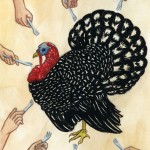From The Eaten Side: The History Of The Thanksgiving Turkey

When the first Thanksgiving was held at Plimoth (i.e. Plymouth) colony in October 1621, there was a wide variety of meat on offer (1). In addition to the five deer that Wampanoag natives provided, tables were also laden with various types of wild fowl such as geese, ducks, quail and even passenger pigeons (once the most numerous bird in the world, but now extinct due to over hunting) (1). Yet of all the animals available for consumption, only turkeys remained associated with the holiday, and are primarily known as the crowning glory of the modern Thanksgiving dinner. To honor the holiday as well as the animal that has helped shape it, Spoon has taken a look into the history of both, from why turkey was so popular a food item to the paradoxical ways we relate to Thanksgiving's most famous dish.
Although Thanksgiving was only declared a national holiday by U.S. President Abraham Lincoln in 1863, the turkey has been a high-status food item since it was first introduced to England in the 1530s (2). Indeed, game animals, such as deer, and fowl, such as turkeys, were always considered more prestigious than "butcher's meat," as they not only took more expense and effort to acquire and prepare, but also had strong connotations to medieval nobility, who had been the only ones allowed to hunt "wild" animals for generations. Once introduced, turkeys came to assume the place of honor that had previously been assigned to geese in ordinary folks' feasts. The very wealthy disdained both, dining on swans and peacocks instead. Yet turkeys remained a popular food item, and a taste for the birds traveled with the immigrants to New England. Here, they found vast populations of wild turkey that soon became one of the colonists' favorite animals to hunt (2).
Wild turkeys were hunted in a number of ways, the most common involving stalking the birds along their trails and roosts, and shooting them as they ran (2). Turkeys were also hunted in the dead of night while they roosted in trees. Always a popular dish, wild turkeys became scarce after the American Revolution, even while their domestic counterparts increased steadily in number. The last wild turkey known to have lived in Massachusetts was killed in Mount Tom on November 1, 1847. The taxidermied body is still preserved in the museum of Yale College. By the mid-nineteenth century, turkey hunting in New England was only a memory. Elisha Lewis in 1856 predicted the extinction of the species, saying, "'Scarcely a bird is now to be encountered on the whole northern and eastern Atlantic seaboard. The destroying hand of the white man is stretched forth, and his victims are vainly seeking an asylum'" (2). By the 1930s, "hunting had so decimated North American wild turkey populations that their numbers had dwindled to the tens of thousands, from a peak of at least tens of millions" (1). Thankfully, this trend has been somewhat reversed due to reintroduction efforts and hunting regulations, and there are now some seven million wild turkeys living in the United States.
In 2012, around 254 million turkeys were raised for slaughter in the U.S., 46 million of which ended up as the centerpieces of Thanksgiving dinners (1). These birds are very different creatures from the ones that were previously seen on the Thanksgiving table, even though domestic turkeys exhibited the sleek build of their ancestors as recently as the 1940s (2). While wild turkeys can run some 10 to 20 mph and fly in bursts at 55 mph, domestic turkeys today can't fly at all (2). Turkeys have also recently been bred to either satisfy the demand for deli meat or for their more traditional role as the Thanksgiving dinner's main course; turkeys raised for sandwich meat weigh more than 40 lbs., whereas the average Thanksgiving turkey weighs around 16 lbs.
While most turkeys are, regardless of breed, intended for the dinner table, there are always exceptions to this rule. Most famously, each year the National Turkey Federation presents two live turkeys—as well as a ready-to-eat bird—to the president of the United States to receive a presidential pardon and avoid being eaten. This Washington tradition of uncertain origin began in 1947 during the Truman Administration. Knowing that multiple turkeys have attacked the president and other personnel after panicking for sensations they were not used to, Mr. Burkel, the farmer supplying this year's turkeys, put the birds through a regime that he hopes will have acclimated them to all the sights, sounds, and smells of the public pardon process (3). Having received the pardon, the turkeys are given a permanent home at Morven Park in Leesburg, Virginia (1). It may be a small gesture in the face of the 46 million turkeys slaughtered for the same day, but it is one that indicates that both turkey and human were important in the making of one of the United States' most important national holidays.
Sources
1. Handwerk, Brian. "Thanksgiving 2013: What to Know About Turkey Day." National Geographic: Daily News. November 22, 2013. http://news.nationalgeographic.com/news/2013/11/131122-thanksgiving-2013-dinner-recipes-pilgrims-day-parade-history-facts/?conf=3b5c6b82-caa0-4fa8-849f-48567afd8501#
2. Baker, James W. Thanksgiving: The Biography of an American Holiday. University of New Hampshire Press. Durham, New Hampshire. 2009.
3. Shallwani, Pervaiz. "For Thanksgiving Turkeys, Presidential Pardon Gig Takes Practice: Mr. Burke Preps Birds for White House Ceremony." The Wall Street Journal: Life and Culture. November 24,2013. http://online.wsj.com/news/articles/SB10001424052702304011304579218182047208114
Newbrough, Nikki. "Iowa farms probably won't be providing the Thanksgiving turkey." KWWL.com. November 24, 2013. http://www.kwwl.com/story/24057877/2013/11/24/iowa-farms- probably-wont-be-providing-the-thanksgiving-turkey
The post From the Eaten Side: The History of the Thanksgiving Turkey appeared first on Spoon University.